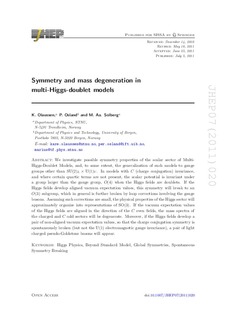| dc.contributor.author | Olaussen, Kåre | |
| dc.contributor.author | Osland, Per | |
| dc.contributor.author | Solberg, Marius Aase | |
| dc.date.accessioned | 2019-10-10T08:56:11Z | |
| dc.date.available | 2019-10-10T08:56:11Z | |
| dc.date.created | 2011-10-11T14:04:42Z | |
| dc.date.issued | 2011 | |
| dc.identifier.citation | Journal of High Energy Physics (JHEP). 2011, (7), . | nb_NO |
| dc.identifier.issn | 1126-6708 | |
| dc.identifier.uri | http://hdl.handle.net/11250/2621334 | |
| dc.description.abstract | We investigate possible symmetry properties of the scalar sector of Multi-Higgs-Doublet Models, and, to some extent, the generalization of such models to gauge groups other than SU(2) L × U(1) Y . In models with C (charge conjugation) invariance, and where certain quartic terms are not present, the scalar potential is invariant under a group larger than the gauge group, O(4) when the Higgs fields are doublets. If the Higgs fields develop aligned vacuum expectation values, this symmetry will break to an O(3) subgroup, which in general is further broken by loop corrections involving the gauge bosons. Assuming such corrections are small, the physical properties of the Higgs sector will approximately organize into representations of SO(3). If the vacuum expectation values of the Higgs fields are aligned in the direction of the C even fields, the mass spectra of the charged and C odd sectors will be degenerate. Moreover, if the Higgs fields develop a pair of non-aligned vacuum expectation values, so that the charge conjugation symmetry is spontaneously broken (but not the U(1) electromagnetic gauge invariance), a pair of light charged pseudo-Goldstone bosons will appear. | nb_NO |
| dc.language.iso | eng | nb_NO |
| dc.publisher | Springer | nb_NO |
| dc.rights | Navngivelse-Ikkekommersiell 4.0 Internasjonal | * |
| dc.rights.uri | http://creativecommons.org/licenses/by-nc/4.0/deed.no | * |
| dc.title | Symmetry and mass degeneration in multi-Higgs-doublet models | nb_NO |
| dc.type | Journal article | nb_NO |
| dc.type | Peer reviewed | nb_NO |
| dc.description.version | publishedVersion | nb_NO |
| dc.source.pagenumber | 20 | nb_NO |
| dc.source.journal | Journal of High Energy Physics (JHEP) | nb_NO |
| dc.source.issue | 7 | nb_NO |
| dc.identifier.doi | 10.1007/JHEP07(2011)020 | |
| dc.identifier.cristin | 844668 | |
| dc.description.localcode | © The Author(s) 2011 Open Access This article is distributed under the terms of the Creative Commons Attribution License which permits any use, distribution and reproduction in any medium, provided the original author(s) and source are credited. CC-BY-NC | nb_NO |
| cristin.unitcode | 194,66,20,0 | |
| cristin.unitname | Institutt for fysikk | |
| cristin.ispublished | true | |
| cristin.fulltext | original | |
| cristin.qualitycode | 2 | |

